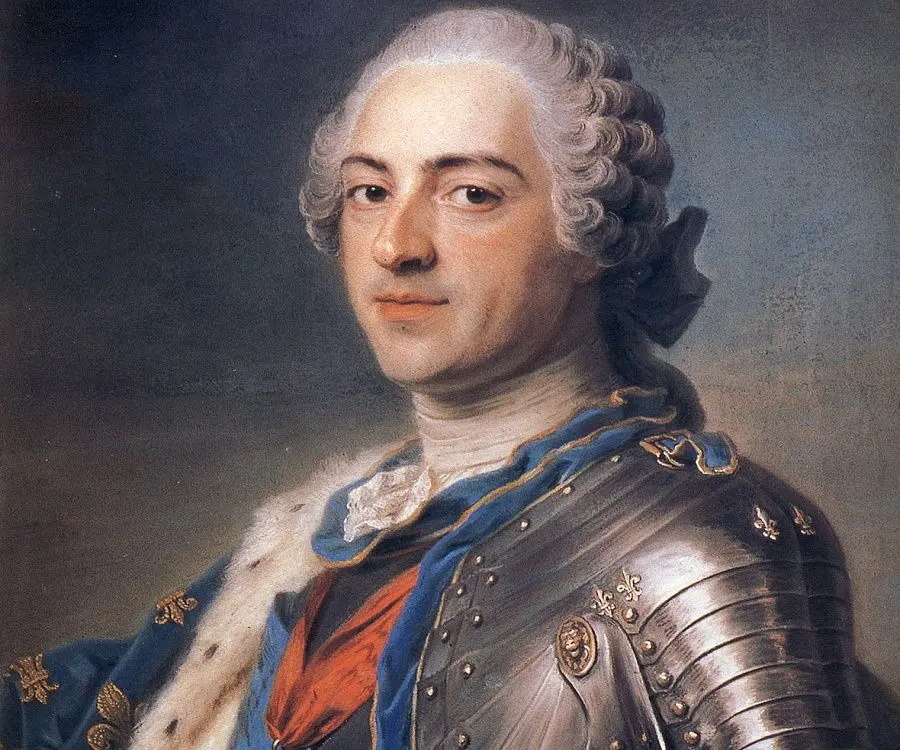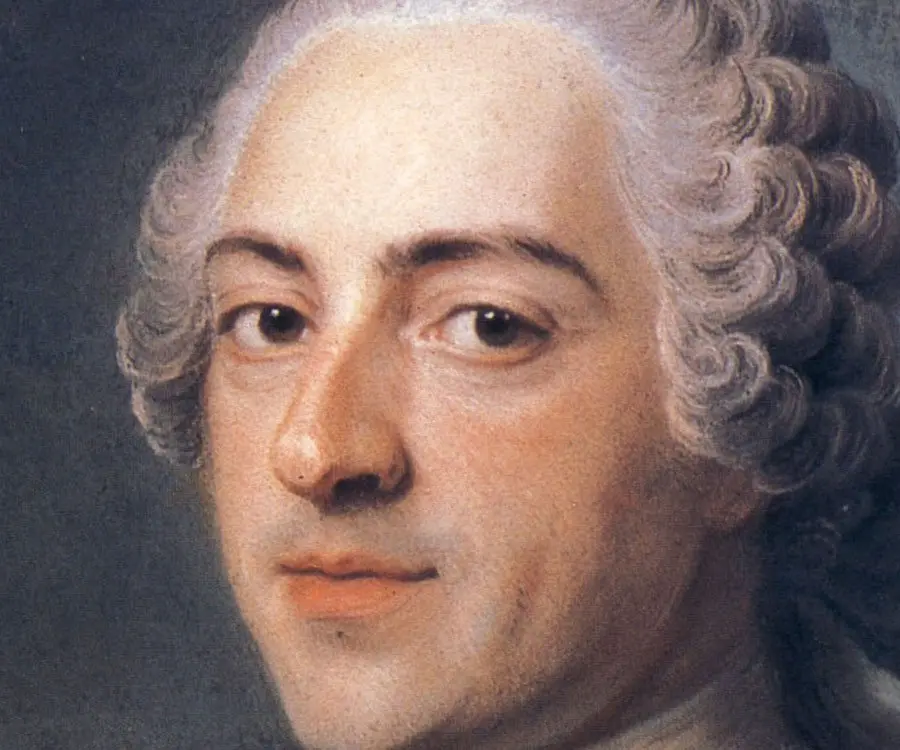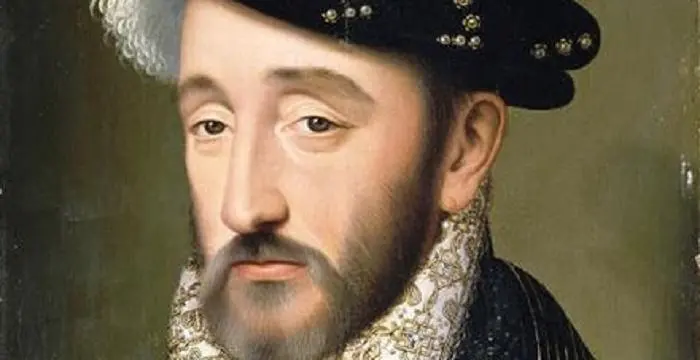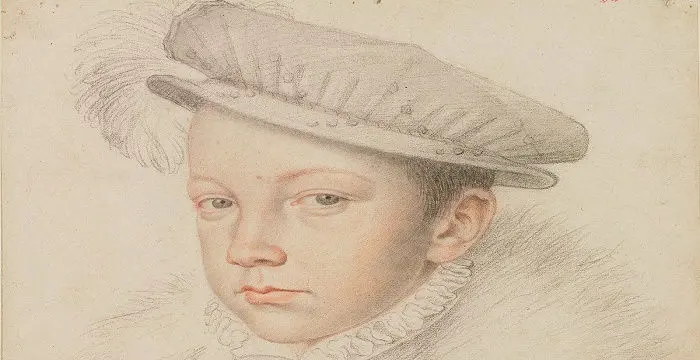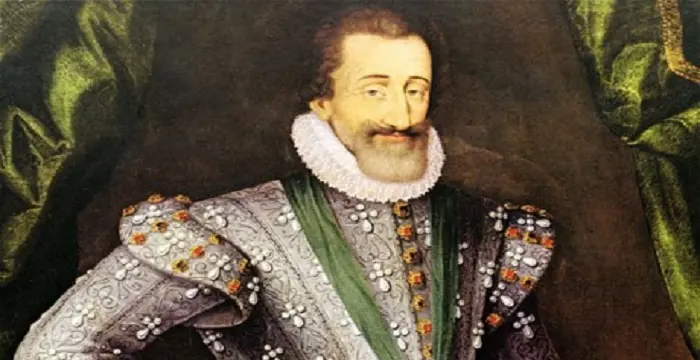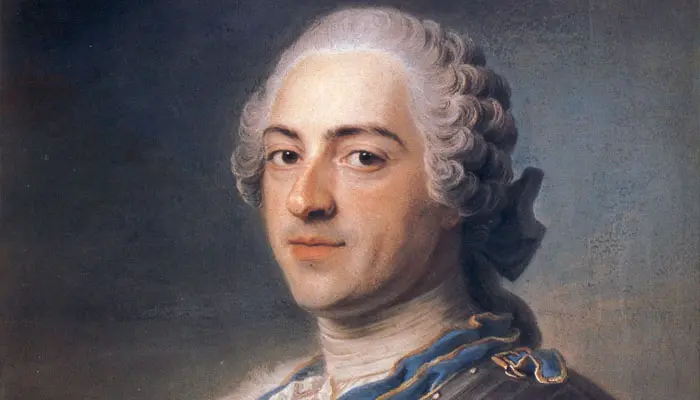
Louis XV of France - Emperors, Family and Family
Louis XV of France's Personal Details
Louis XV, also known as Louis the Beloved, was the as King of France from 1 September 1715 until his death in 1774.
| Information | Detail |
|---|---|
| Birthday | February 15, 1710 |
| Died on | May 10, 1774 |
| Nationality | French |
| Famous | Historical Personalities, Emperors & Kings, Emperors, King of France, Kings |
| Spouses | Marie Leszczyńska (1725–68; her death) |
| Known as | Louis the Beloved |
| Childrens | Abbess of Saint Denis, Dauphin of France; Philippe, Duchess of Parma; Princess Henriette, Duke of Anjou; Princess Marie Adélaïde, Louise Élisabeth, Princess Marie Louise; Louis, Princess Sophie, Princess Thérèse Louise, Princess Victoire |
| Birth Place | Palace of Versailles, Versailles, Yvelines |
| Religion | Roman Catholicism |
| Gender | Male |
| Father | Louis, Duke of Burgundy |
| Mother | Marie Adélaïde of Savoy |
| Sun Sign | Aquarius |
| Born in | Palace of Versailles, Versailles, Yvelines |
| Famous as | King of France |
| Died at Age | 64 |
// Famous Emperors
Sundiata Keita
Sundiata Keita was the founder of the Mali Empire in West Africa. This biography profiles his childhood, early life, struggles, founding of empire, rule, administration, achievements and also gives some fun facts.
Ashoka
Ashoka was the third emperor of the Mauryan Dynasty and ruled almost the entire Indian subcontinent. This biography profiles his childhood, life, reign, achievements and timeline
Murad IV
Murad IV was one of the mighty Sultans in the history of the Ottoman Empire. This biography profiles his childhood, family, accession, rule, administration and timeline.
Louis XV of France's photo
Who is Louis XV of France?
Louise XV was the King of France from 1715 to 1774. Though known as ‘Louis – The Beloved,’ his rule contributed to the decline of the royal authority, which led to the ‘French Revolution.’ He succeeded his great-grandfather, King Louis XIV, when he was 5. The country was initially governed by Regent, Duke of Orléans, till Louis reached majority. Later, Cardinal Fleury took control of the state affairs as a Chief Minister till his death. After that, Louis ruled the nation by himself. Louis governed France for 59 years, second longest in France’s history, only next to his great-grandfather, Louis XIV, who ruled for 72 years. France was involved in 3 major wars during his reign, which had an adverse effect on the state treasury. He was a failure at providing strong leadership and necessary reforms, which led to a weakened state administration. Louis was married to Marie Leszczyńska, the daughter of deposed king of Poland. He also took a number of mistresses, the famous one being Madame Pompadour, who was his close confidante and advisor in state matters. He died due to small pox at the age of 64.
// Famous King of France
Henry II of France
Henry II of France was a monarch who ruled France from 1547 to 1559. Check out this biography to know about his birthday, childhood, family life, achievements and fun facts about him.
Francis II of France
Francis II of France was the eldest son of King Henry II and Catherine de’ Medici. Check out this biography for more information about his childhood, family, personal life, etc.
Henry IV of France
Henry IV was King of Navarre and King of France from 1589 to 1610. This biography of Henry IV profiles his childhood, life, reign, achievements and timeline.
Childhood & Early Life
Louis XV was born on February 15, 1710, at the Palace of Versailles, to Louis Bourbon, Duke of Burgundy and Marie Adelaide of Savoy. At birth he was created Duke of Anjou and succeeded his great-grandfather Louis XIV, after his death in 1715. Louis became king at the age of 5.
Phillipe, Duke of Orléans, ruled the nation as Regent till Louis reached the age of 13. In 1717, François de Villeroy was appointed as Governor to coach 7 year old king in royal duties, etiquettes and skills. He was tutored by Abbé André-Hercule de Fleury, Bishop of Fréjus, who later became Cardinal de Fleury. Louis had a keen interest in science.
In 1721, a marriage was settled between Louis and Infanta Maria Anna Victoria, the young daughter of Louis’s uncle, King Philip V of Spain. But later the Regent felt that she was too young to bear children soon, so she was sent back.
Reign of King Louis XV
Coronation of Louis XV took place in the Cathedral of Reims on October 25, 1722. The Regency was officially ended and king’s majority was announced on February 15, 1723. The Regent died that same year and on Fleury’s advice Louis Henri, Duke of Bourbon, was made the Prime Minister.
On September 5, 1725, the 15 year old King Louis XV was married to 21 year old Marie Leszczyńska, daughter of the dethroned King Stanislaw I of Poland, at Château de Fontainebleau. The intention of this marriage was to obtain a heir to secure the survival of the dynasty. The queen gave birth to 8 daughters and 2 sons between 1727 and1737, but only 7 children lived till adulthood. One son, Dauphin Louis, survived to continue the lineage. The queen spent most of her time with her courtiers and pursued music and reading.
At the beginning of his reign, there were strains over religious differences. Earlier, the religious figures were exempted from tax, but new tax levied on clergy raised discontent. Also, the repressive acts caused religious discontent which continued through his reign.
The King relied more on Fleury than Duke of Bourbon. This created tensions between the two and King removed the Duke. Louis was not strong at decision-making, thus Fleury ruled all the state affairs from 1726 to his death in 1743.
Though it was a peaceful period of the King’s reign, there was growing discontent amidst the nobles of Parlement. Under Fleury’s administration, a number of improvements were made such as extensive and systematic national road network, better transportation and shipping, improved trade within the country and also with other countries.
The King’s reign was marked with 3 major wars – War of Polish SuccessionIn 1733, a Polish civil war over the succession to their King Augustus II, widened in a major European war. Louis led the French army in order to reinstate his father-in-law, Stanislaw I, to the Polish throne. Louis couldn’t help Stanislaw, but won Duchy of Lorraine, which he granted to Stanislaw with the condition that, on Stanislaw’s death, it would be returned to Louis. (In 1766, after Stanislaw’s death, the Duchy of Lorraine and Bar came under French rule).War of Austrian Succession
In 1740, after the death of Austrian King Charles VI, there were disputes over succession. France decided to fight alongside Prussia, while the British fought on the Austrian side. This war continued till 1748, with many changes in the alliances. The long-drawn war proved expensive for the French treasury. Cardinal Fleury died in January 1743, but Louis did not appoint any Prime Minister and ruled by himself.
During this ‘War of Austrian succession’ French won many territories. In October 1748, a treaty was negotiated at Aix-la-Chapelle, wherein Louis generously offered to return all the territories to their rightful owners. He was praised by the European countries, but faced criticism in France.
After the war, Louis brought in many reforms, especially financial ones to pay back the debts of costly war. Some of his reforms were welcomed by many, but as the new taxes were meant for all, including noblemen and clergy, it created discontent.
Apart from his beloved queen, Louis was also involved with a series of mistresses, the first being Louise Julie de Mailly, the eldest of the de Mailly sisters whom he took for his mistresses. He took the youngest sister on battle-front at Versailles (1744).
In August 1744, Louis became very ill in Metz (at the battlefield). Everyone was afraid of the worst and prayers were arranged across the state. When he survived the illness, his countrymen were relieved and called him ‘The Beloved.’
Among the King’s mistresses, Jeane-Antoinette Poisson or Madame de Pompadour was most famous and powerful one. Louis formally met her at a costume ball in 1745. Soon she became King’s chief mistress and received the title of ‘Marquise de Pompadour.’ Till her death in 1764, she remained his close friend and advisor. She was patron of art and music. She aided the King in court matters, thus it resulted in removal of some capable courtiers and inclusion of some inefficient ones.
In 1748, Louis set up a secret diplomacy system, ‘le secret du roi,’ through which French secret agents were posted around the major European cities to pursue the King’s political objectives. But as his court ministers were not aware of this secret system, it created confusions, so Louis temporarily left it in 1756.Seven Years’ War
Conflicts between Britain and France over their colonies were on rise. In June 1756, Louis declared war with England, which was the beginning of the ‘Seven Years’ War.’ Initially France appeared to be gaining, but Britain’s naval force was much stronger, France had difficulty in reaching its far-off colonies. In September 1760, the French rule ended in Canada.
A demented person, Robert-François Damien attacked and stabbed the king in his side with a small knife on January 5, 1757, at Grand Trianon Versailles. Louis suffered injury, but recovered speedily. The assailant received severe sentence of ‘execution by drawing and quartering.’
Louis made an attempt to strengthen the authority of crown and re-organize the government. The Parlements of various provinces resisted these reforms. Louis took action against the members of Parlements, so finally they did concede but the resistance to king’s authority continued and the seeds of Revolution were sown.
On Madame de Pompadour’s recommendations, in December 1758 Duke de Choiseul was appointed minister of foreign affairs. Later (1763) he became minister of war and then minister of Navy, thus becoming a commanding member of the court. He accomplished many achievements for the state and made important modern reforms to military.
The Parlements in France were against Jesuits. Though King’s family supported Jesuits, Madame de Pompadour was against. The King issued ‘Suppression of Jesuit Order’ in 1764.
The ‘Seven Years’ War’ proved expensive for the French treasury. But the new taxes met with opposition. So the King, on Madame Pompadour’s advice, cancelled the taxes and the debt persisted.
The ‘Seven Years’ War’ continued and France’s proposal for negotiations was rejected in 1761 by British Premier. Choiseul took initiative in strengthening French army and navy, but the French force proved inadequate against Britain and allies. In February 1763 a treaty was signed at Paris. France got to keep some of her possessions, but lost many of her colonies to Britain.
Louis was grief-stricken after Madame Pompadour’s death in April 1764. This was followed by his son’s death in December 1765 and the queen died in June 1768.
The Parlements continued to oppose King’s authority. In March 1766, he addressed the members; his speech is known as ‘Flagellation.’ The resistance subsided for the time-being.
In 1769, Louis took Jeane Bécu, Comtesse du Barry, who was 33 years younger than him, as his chief mistress. She lived in Palace of Versailles and was with the King till his death.
Choiseul was removed from his post in 1770 and Chancellor René de Maupeou was appointed as leader of the government. He took action against unruly Parlements and brought strict reforms.
During a hunting trip in April 1774, the King fell ill. It was diagnosed that he was suffering from small pox. He died on May 10, 1774. Though popular as ‘The Beloved’ during his earlier days, Louis died as an unloved king.
// Famous Kings
Sundiata Keita
Sundiata Keita was the founder of the Mali Empire in West Africa. This biography profiles his childhood, early life, struggles, founding of empire, rule, administration, achievements and also gives some fun facts.
Ashoka
Ashoka was the third emperor of the Mauryan Dynasty and ruled almost the entire Indian subcontinent. This biography profiles his childhood, life, reign, achievements and timeline
Murad IV
Murad IV was one of the mighty Sultans in the history of the Ottoman Empire. This biography profiles his childhood, family, accession, rule, administration and timeline.
Louis XV of France biography timelines
- // 15th Feb 1710 To 1715Louis XV was born on February 15, 1710, at the Palace of Versailles, to Louis Bourbon, Duke of Burgundy and Marie Adelaide of Savoy. At birth he was created Duke of Anjou and succeeded his great-grandfather Louis XIV, after his death in 1715. Louis became king at the age of 5.
- // 1717Phillipe, Duke of Orléans, ruled the nation as Regent till Louis reached the age of 13. In 1717, François de Villeroy was appointed as Governor to coach 7 year old king in royal duties, etiquettes and skills. He was tutored by Abbé André-Hercule de Fleury, Bishop of Fréjus, who later became Cardinal de Fleury. Louis had a keen interest in science.
- // 1721In 1721, a marriage was settled between Louis and Infanta Maria Anna Victoria, the young daughter of Louis’s uncle, King Philip V of Spain. But later the Regent felt that she was too young to bear children soon, so she was sent back.
- // 25th Oct 1722 To 15th Feb 1723Coronation of Louis XV took place in the Cathedral of Reims on October 25, 1722. The Regency was officially ended and king’s majority was announced on February 15, 1723. The Regent died that same year and on Fleury’s advice Louis Henri, Duke of Bourbon, was made the Prime Minister.
- // 1726 To 1743The King relied more on Fleury than Duke of Bourbon. This created tensions between the two and King removed the Duke. Louis was not strong at decision-making, thus Fleury ruled all the state affairs from 1726 to his death in 1743.
- // 1733 To 1766The King’s reign was marked with 3 major wars – War of Polish SuccessionIn 1733, a Polish civil war over the succession to their King Augustus II, widened in a major European war. Louis led the French army in order to reinstate his father-in-law, Stanislaw I, to the Polish throne. Louis couldn’t help Stanislaw, but won Duchy of Lorraine, which he granted to Stanislaw with the condition that, on Stanislaw’s death, it would be returned to Louis. (In 1766, after Stanislaw’s death, the Duchy of Lorraine and Bar came under French rule).War of Austrian Succession
- // 1744Apart from his beloved queen, Louis was also involved with a series of mistresses, the first being Louise Julie de Mailly, the eldest of the de Mailly sisters whom he took for his mistresses. He took the youngest sister on battle-front at Versailles (1744).
- // Aug 1744In August 1744, Louis became very ill in Metz (at the battlefield). Everyone was afraid of the worst and prayers were arranged across the state. When he survived the illness, his countrymen were relieved and called him ‘The Beloved.’
- // 1745 To 1764Among the King’s mistresses, Jeane-Antoinette Poisson or Madame de Pompadour was most famous and powerful one. Louis formally met her at a costume ball in 1745. Soon she became King’s chief mistress and received the title of ‘Marquise de Pompadour.’ Till her death in 1764, she remained his close friend and advisor. She was patron of art and music. She aided the King in court matters, thus it resulted in removal of some capable courtiers and inclusion of some inefficient ones.
- // 1748 To 1756In 1748, Louis set up a secret diplomacy system, ‘le secret du roi,’ through which French secret agents were posted around the major European cities to pursue the King’s political objectives. But as his court ministers were not aware of this secret system, it created confusions, so Louis temporarily left it in 1756.Seven Years’ War
- // Oct 1748During this ‘War of Austrian succession’ French won many territories. In October 1748, a treaty was negotiated at Aix-la-Chapelle, wherein Louis generously offered to return all the territories to their rightful owners. He was praised by the European countries, but faced criticism in France.
- // Jun 1756 To Sep 1760Conflicts between Britain and France over their colonies were on rise. In June 1756, Louis declared war with England, which was the beginning of the ‘Seven Years’ War.’ Initially France appeared to be gaining, but Britain’s naval force was much stronger, France had difficulty in reaching its far-off colonies. In September 1760, the French rule ended in Canada.
- // 5th Jan 1757A demented person, Robert-François Damien attacked and stabbed the king in his side with a small knife on January 5, 1757, at Grand Trianon Versailles. Louis suffered injury, but recovered speedily. The assailant received severe sentence of ‘execution by drawing and quartering.’
- // Dec 1758 To 1763On Madame de Pompadour’s recommendations, in December 1758 Duke de Choiseul was appointed minister of foreign affairs. Later (1763) he became minister of war and then minister of Navy, thus becoming a commanding member of the court. He accomplished many achievements for the state and made important modern reforms to military.
- // 1761 To Feb 1763The ‘Seven Years’ War’ continued and France’s proposal for negotiations was rejected in 1761 by British Premier. Choiseul took initiative in strengthening French army and navy, but the French force proved inadequate against Britain and allies. In February 1763 a treaty was signed at Paris. France got to keep some of her possessions, but lost many of her colonies to Britain.
- // 1764The Parlements in France were against Jesuits. Though King’s family supported Jesuits, Madame de Pompadour was against. The King issued ‘Suppression of Jesuit Order’ in 1764.
- // Mar 1766The Parlements continued to oppose King’s authority. In March 1766, he addressed the members; his speech is known as ‘Flagellation.’ The resistance subsided for the time-being.
- // 1769In 1769, Louis took Jeane Bécu, Comtesse du Barry, who was 33 years younger than him, as his chief mistress. She lived in Palace of Versailles and was with the King till his death.
- // 1770Choiseul was removed from his post in 1770 and Chancellor René de Maupeou was appointed as leader of the government. He took action against unruly Parlements and brought strict reforms.
- // 10th May 1774During a hunting trip in April 1774, the King fell ill. It was diagnosed that he was suffering from small pox. He died on May 10, 1774. Though popular as ‘The Beloved’ during his earlier days, Louis died as an unloved king.
// Famous Emperors & Kings
Sundiata Keita
Sundiata Keita was the founder of the Mali Empire in West Africa. This biography profiles his childhood, early life, struggles, founding of empire, rule, administration, achievements and also gives some fun facts.
Ashoka
Ashoka was the third emperor of the Mauryan Dynasty and ruled almost the entire Indian subcontinent. This biography profiles his childhood, life, reign, achievements and timeline
Murad IV
Murad IV was one of the mighty Sultans in the history of the Ottoman Empire. This biography profiles his childhood, family, accession, rule, administration and timeline.
Xerxes I
Xerxes I (Xerxes the Great) was the fourth and the most famous king of the Archaemenid dynasty of Persia. This biography profiles his childhood, family, personal life, life history, achievements, campaigns, administration, death and other facts.
Sargon of Akkad
Sargon of Akkad, also called ‘Sargon the Great’, ‘Sarru-Kan’ and ‘Shar-Gani-Sharri’, was the founder and first king of the Akkadian Empire. This biography profiles his childhood, life, rule, administration, timeline, and gives some fun facts.
Abdullah of Saudi Arabia
Abdullah bin Abdulaziz Al Saud was the King of Saudi Arabia from 2005 to 2015 and the third wealthiest head of state in the world. Find more facts about his life, childhood and timeline.
Louis XV of France's FAQ
What is Louis XV of France birthday?
Louis XV of France was born at 1710-02-15
When was Louis XV of France died?
Louis XV of France was died at 1774-05-10
Where was Louis XV of France died?
Louis XV of France was died in Palace of Versailles, France
Which age was Louis XV of France died?
Louis XV of France was died at age 64
Where is Louis XV of France's birth place?
Louis XV of France was born in Palace of Versailles, Versailles, Yvelines
What is Louis XV of France nationalities?
Louis XV of France's nationalities is French
Who is Louis XV of France spouses?
Louis XV of France's spouses is Marie Leszczyńska (1725–68; her death)
Who is Louis XV of France childrens?
Louis XV of France's childrens is Abbess of Saint Denis, Dauphin of France; Philippe, Duchess of Parma; Princess Henriette, Duke of Anjou; Princess Marie Adélaïde, Louise Élisabeth, Princess Marie Louise; Louis, Princess Sophie, Princess Thérèse Louise, Princess Victoire
What is Louis XV of France's religion?
Louis XV of France's religion is Roman Catholicism
Who is Louis XV of France's father?
Louis XV of France's father is Louis, Duke of Burgundy
Who is Louis XV of France's mother?
Louis XV of France's mother is Marie Adélaïde of Savoy
What is Louis XV of France's sun sign?
Louis XV of France is Aquarius
How famous is Louis XV of France?
Louis XV of France is famouse as King of France



